总结图像冒险游戏适用的12种谜题类型
作者:Ryan Henson Creighton
图像冒险游戏是我最喜欢的电子游戏题材,该题材于90年代中期消亡,因为游戏行业的关注焦点逐渐从故事、幽默和角色设计转向动作、暴力和复仇。
所以我计划借助这个项目来构建图像游戏引擎,这样我以后就能够更容易地制作更多这种类型的游戏。
我开始思考引擎的内容,比如我需要构建何种工具集以及引擎需要支持哪些通用于图像冒险游戏中的功能。我开始思考玩家与这些游戏互动的方式——谜题,玩家通过这种游戏玩法机制在游戏中取得进展。以下便是出现在图像冒险游戏中的不同种类谜题:
1、道具使用
几乎所有的图像冒险游戏都有仓库,玩家可以将故事体验过程中收集到的道具储存其中。玩家将这些道具运用于角色或环境中的对象上,可以产生改变。最简单的例子是锁和钥匙,在门锁前使用钥匙,门就会打开。
现代MMO游戏中抵达目的地的探索就是简单的锁和钥匙谜题。给海盗提供朗姆酒就可以登船,给海鸥食物就可以通过和爬进废料箱中。
道具谜题也可能是连锁式的,单个解决方案需要多个道具或多次环境互动。这个方面,我最喜欢的是《猴岛的秘密:勒恰克的复仇》中的设计。
你需要金钱来租赁船只。游戏中唯一可以获得金钱的方式是被餐馆雇佣,但他们已经雇佣了一名厨师。根据冒险游戏的逻辑,很显然你需要让餐馆解雇这名厨师,这样你才能获得这份工作。要实现这个目标,我需要从附近的场景中抓到一只老鼠。通过使用仓库中3种不同的道具,我可以制作出捕捉老鼠的陷阱。这种谜题就相当于需要使用多个钥匙的锁。最终,我将捕捉到的这只老鼠放在餐馆的汤中,于是那个可怜的厨师被开除了。
环境中的道具可以用来完成谜题,也可以用来制作新的道具。在上述例子中,使用3种道具可以制造出捕鼠夹,这样老鼠就会成为你仓库中的可使用道具。所以,老鼠也是整个大谜题的一部分。
2、道具组合
有时玩家需要将仓库中的两件道具组合以形成第3件新道具,这样的谜题显得愈发复杂。这个新道具便是解开锁的钥匙。在《魔法师西蒙》中,在“磁铁”道具上使用“绳索”道具可以制造出“绳索和磁铁”道具。从洞中放下这个道具,可以从龙穴中偷出钱币。
尽管道具组合是很精妙的做法,但游戏设计师在这方面必须谨慎。在所有的图像冒险谜题中,设计师应当确保组合道具的目标既清晰又符合逻辑。否则,你最后的产品就会变得像《重返神秘岛》那样,所有的道具组都是毫无根据的。长木棍+麻绳+灰色石头=鱼竿,然而短木棍+绳索+黑色石头=短柄小斧。
道具组合还可以包括反向工程。有时,玩家可以直接操作或使用道具,也可以在某道具上使用另一种道具,将其分解成两个或者更多的道具成分。举个经典的例子,将手电筒变成破损的手电筒和一对电池。
3、环境谜题
尽管拾取环境中的道具是件很有趣的事情,但有些谜题只需要玩家正确地使用屏幕上的道具即可,比如拉动杠杆来开门。
《急速天龙》的开放场景在环境谜题上做了创新。Ben从倔强的酒吧男招待处获得了消息,使用的方法是拉住他的鼻环将他的脸砸向吧台。
4、导航
导航谜题要求玩家小心地在屏幕中移动角色,面临着受到惩罚的危险。在Sierra On-Line发布的图像冒险游戏中,这种惩罚往往是令人沮丧的死亡。
在《Space Quest II: Chapter II: Vohaul’s Revenge》中,Roger Wilco需要轻步通过布满毒性植物触须的死亡迷宫。
同样,在《King’s Quest III: To Heir is Human》中,Gwydion需要多次行走于危险的山道上。
《Endless Maze》采用的是这种谜题的变体。玩家进入一个房间会无限重复的迷宫。玩家只有找到正确的路径并直接选择走这条路才能够生存下来,否则便有在野地里死亡的危险。在《The Dallas Quest》中,通过无尽麦田的路径刻在前冒险者的墓碑上。
5、分散注意力
分散注意力谜题在LucasArts冒险游戏中很常见,玩家面对的是NPC。NPC往往会阻止玩家偷窃东西,所以玩家需要分散这个NPC的注意力,这样就可以从他看管的仓库中拿到东西。
在《异形大进击》中,Zak要在飞机上拿到许多很重要的货物。但是,空姐一直告诉他将货物放回原处。于是,Zak走到机尾处,堵住了那里的水槽,再到飞机前部将鸡蛋放入微波炉中,制造出一系列麻烦,让空姐无暇顾及他的其他行动。
6、操作顺序
有些谜题需要玩家按照特定顺序开展行动。上述Zork的例子便是如此。
Infocom文字游戏《银河系漫游指南》中的经典宝贝鱼谜题也值得一提,尽管它不是个图像冒险游戏。登上外星人的飞船后,玩家需要从贩卖机中获得宝贝鱼。这条鱼能够帮助玩家理解外星人的语言。在有限的时间里,玩家必须按动按钮,看着这条难以捉摸的鱼多次消失:通过墙壁上的洞、通过地板上的机器人面板、被负责清扫飞船的机器人等。通过使用仓库中的道具(游戏邦注:一件晨衣、一条毛巾和一个书包),玩家挨个避开这些问题,最终还是有可能面临失败:
一条宝贝鱼从狭槽中射出。它游过房间,撞到晨衣。鱼顺着衣服的袖筒滑落到地板,掉到毛巾上。几秒钟后,一个小型清扫机器人清扫地板,捕获了这条鱼,并继续走向放在墙根处的机器人面板。书包挡住了机器人,使这条鱼被抛到空中。一个负责房间上半部分的清扫机器人抓到了宝贝鱼,随后离开房间。
经过多次尝试和修改,宝贝鱼最终落在了角色的耳朵上。
7、对话
许多图像冒险游戏使用对话树来实现玩家与不同角色的互动。NPC说了些话,玩家可以从许多回应中做出选择。在某些游戏中,玩家的成功与否完全取决于所做出的对话选择。
在《夺宝奇兵3:圣战奇兵》中,为避免麻烦,玩家在Brunwald城堡中必须通过谨慎地选择答案来回应每个纳粹卫兵。
8、计时
偶尔,玩家会在游戏中遇到动画序列,必须在数帧动画的时间内电击热点来解除障碍。《猴岛的秘密》系列中每款游戏的高潮末端都是这种类型的挑战。
在《断剑》(游戏邦注:也称为《Circle of Blood》)中,游戏的最高难度谜题需要George快速点击来逃离愤怒的山羊。
9、小游戏和小谜语
冒险游戏玩家是个很奇怪的群体。我记得当冒险游戏开始引进某些快速动作元素(游戏邦注:比如《圣战奇兵》中的战斗内容)时,冒险游戏评论会具体指出游戏有无动作成分,以防部分玩家不喜欢这种类型的游戏玩法。许多冒险者将此类动作元素视为干扰要素,破坏了原游戏体验,他们缺乏通过这些事件的快速动作技能和手眼协调。就我个人而言,飞艇上的战斗内容使我无法打通《圣战奇兵》的最后部分。
节奏不恰当的小游戏是冒险游戏中更为普遍出现的元素,这些小游戏涉及回合制的移动或单调乏味的战略。这种内容的出现会产生相反的效果,纯冒险主义者会怀疑这款游戏能否被称为冒险游戏。《第7访客》将经典战略、桌游和纸上谜题结合到全动作电子游戏框架中,并自诩称为冒险游戏。
《第7访客》之类的游戏往往使用已经存在的谜题。它们包含可能是你之前已经听过的陈旧谜题和你之前已经解决过的挑战,比如《Zork Zero》中的“Tower of Bozbar”谜题。
10、不合情理的道具
不合情理道具谜题是种直观的拾取道具动作,其复杂之处在于玩家不会马上意识到该道具可以拾取。
在《Leisure Suit Larry Goes Looking for Love》中,Larry Laffer访问Quickie Mart,推下1000加仑的Grotesque Gulp。
但是,《猴岛的秘密2:勒恰克的复仇》中Guybrush Threepwood藏在船只中的猎犬是个更为绝妙的例证。
11、现实世界研究
出于反盗版的目的,有些游戏通过包装盒向玩家发送解决游戏中某些谜题所需的实物资料。这些资料往往被视为保护版权的方法。在《Freddy Pharkas: Frontier Pharmacist》中,有些用户要求Freddy为他们制作某些19世纪的东西。如果玩家没有随游戏赠送的《The Modern Day Book of Health and Hygiene》,就无法解开这个谜题。
在《DreamWeb》中,主角Ryan无法进入自己家,除非玩家在随游戏包发送的《Diary of a Mad》中寻找密码。
《Where in the World is Carmen Sandiego》随游戏附送了一张世界历表,玩家可以用来跟踪游戏中的恶棍,尽管这款游戏不算是图像冒险游戏。事实上,让孩子们使用历表来研究各个国家也是游戏的教育目标之一。
12、团队合作
某些我最喜欢的图像冒险游戏允许玩家控制两个或更多的角色。这使游戏中出现更多有趣的谜题,比如,要用一个角色按住开关来帮助另一个角色走出地下城。这种设计出现在原版《疯狂豪宅》中,玩家可以控制3个不同的角色,从残忍的疯癫科学家手中救出啦啦队队长。
游戏中最令人兴奋和揪心的时刻是,需要控制一个角色按门铃,然后躲藏在灌木丛中。疯癫科学家的儿子Weird Ed会去打开门,于是第二个角色就有机会在有限的时间内搜索他的卧室。这也是之前提到过的转移注意力的技巧,通过让玩家控制多个角色使之更具挑战性。
毫无意义的谜题
不幸的是,导致图像冒险游戏消亡的原因之一是,玩家在被某些谜题难住时会感到束手无策。如果这种情况在游戏初期发生,那么这个玩家就会失去几乎整款游戏的精妙体验。诚然,游戏公司会销售通关秘籍。但是,对玩家来说,已经花了60美元却只能体验1/3的内容,只有再花15美元购买通关提示内容才能继续进展下去,这着实令人感到十分沮丧。
现在,我们可以上网找GameFAQ,这个问题就会更容易得到解决。但是在当时,你会震惊的发现,某些公司制作游戏时就是为了售出更多的通关秘籍。
Sierra On-Line便是如此,游戏中需要将各种毫无联系的道具组合使用,来解决某些毫无意义的谜题。
如果要说游戏系列因为谜题设计不当而完全失去市场,那就不得不提到《顽皮小精灵》。
以下是一则《顽皮小精灵2》的游戏问答:从头盔处获得羽毛。在红色罐子上使用羽毛。在洞口处使用蟑螂。在蟑螂上使用刷子、胡椒粉和药剂。
《顽皮小精灵》在游戏中组合使用了多种谜题类型,包括团队合作、道具使用、仓库道具组合和限时。其组合的不当之举完全可以成为图像冒险游戏设计的反面教材。
我很赞成大家用自己赚来的钱购买游戏,但对这款游戏来说例外。如果你觉得玩盗版游戏有罪恶感的话,还不如将计划花在这款游戏上的钱捐献给慈善组织。
游戏邦注:本文发稿于2009年8月26日,所涉时间、事件和数据均以此为准。(本文为游戏邦/gamerboom.com编译,拒绝任何不保留版权的转载,如需转载请联系:游戏邦)
12 Types of Puzzles in Graphic Adventure Games
Ryan Henson Creighton
One of our clients has contracted us to build a Graphic Adventure game, and we’re jazzed. This is my absolute favourite video game genre, one that died in the mid-90′s as jocks started playing games, and the focus turned from story, humour and character design to action, violence and tits.
Most of my unproduced game ideas are for Graphic Adventure games. So i’m toying with the idea of using this project as an excuse to build a Graphic Adventure Game engine, so that i can more easily produce additional games in that style.
So i started to think about what that engine would look like – what sorts of toolsets i would have to build, and which common Graphic Adventure game features i would need to support. i started thinking about the way in which players interact with these games: puzzles, the gameplay mechanisms than enable players to progress through the game. Here then, for your edification, is a list of different types of puzzles found in Graphic Adventure games.
Advanced warning: here be spoilers.
Item Use
Nearly all Graphic Adventure games have some sort of inventory, a place where the player can store items he’s collected throughout the story. The player applies these items to characters or objects in the environment to effect a change. The most simple example is a lock and a key: apply the key to the door lock and the door opens.
Modern MMO fetch quests are simple lock-and-key puzzles. Give the pirate some rum to get onto the ship. Give the seagull a french fry so that you can walk past him and climb into the dumpster.
Item puzzles can be daisy-chained so that a single solution requires multiple item/environment interactions. My very favourite example (from my very favouritest game ever) is in The Secret of Monkey Island 2: LeChuck’s Revenge.
You need money to charter a ship. The only place hiring is a restaurant, and they’ve already hired a chef. Through devious adventure game logic, it’s clear that you have to get the chef fired so that you can take his job. It amuses me that as soon as i found a rat on a nearby screen, i knew exactly what to do. By using three different items in your inventory, you construct a trap to catch the rat. The puzzle is one big lock using multiple keys. (The rat somehow ends up in the restaurant’s soup, and the poor chef is sent packing.)
Using items on the environment could complete the puzzle, or it could produce a new item. In this case, use three items to build a rat trap, which gives you a rat as an inventory item. The rat is part of a bigger puzzle.
Item Combination
Puzzles can get even more complicated when the player has to combine two items in his inventory to form a third, new item. The new item becomes a key to open a lock. In Simon the Sorceror, use the “rope” item on the “magnet” item to create the “rope and magnet” item. Drop this item down a hole to swipe money from a dragon’s cave.
While item combination can be very rewarding, game designers have to be careful. As with all Graphic Adventure puzzles, designers should ensure that the reason for combining items – the goal – is clear and logical. Otherwise, you wind up with a game like Return to Mysterious Island, which features almost arbitrary item combinations and recipes. Long stick + twine + grey rock = fishing rod, while short stick + rope + black stone = hatchet. Ugh.
Item combination can also include reverse engineering. Sometimes the player can manipulate or examine an item, or use another item on it, to break it into two or more component items. A classic example of this is opening a flashlight to produce a broken flashlight and a pair of batteries.
Environment Puzzle
Picking up “anything that isn’t nailed down” is tons of fun, but some puzzles simply require the player to fiddle with items right on the screen. A simple example is pulling a lever to open a door.
A creative take on the environment puzzle crops up in the opening scene of Full Throttle. Tough guy Ben extracts info from an obstinate bartender by grabbing his nose ring and smashing his face against the bar.
Navigation
Navigation puzzles require the player to carefully steer the character around the screen, or risk a penalty. As par for the course in Sierra On-Line Graphic Adventures, this penalty was usually a frustrating death sequence.
In Space Quest II: Chapter II: Vohaul’s Revenge, Roger Wilco has to tread lightly through a deadly maze of poisonous plant tendrils.
Similarly, in King’s Quest III: To Heir is Human, Gwydion has to schlepp his way up and down a perilous mountain path not once, not twice, but like a million times.
A variation on this is the Endless Maze. The player reaches a rigged maze of endlessly repeating rooms. The player can only survive by learning of the correct route and taking it directly, or risk perishing in the wilderness. In The Dallas Quest, the path through the endless wheat field is etched on the tombstone of a pervious adventurer.
Diversion
Prevalent in many LucasArts adventure games, the distraction puzzle pits the player against a non-player character. The npc usually won’t allow the player to steal things in the immediate vicinity, so the player cooks up a distraction to occupy the npc, leaving him free to pad his inventory.
In Zak McKracken and the Alien Mindbenders, Zak has to nab a number of probably crucial goodies from his seat in the airplane. But would you believe it? The witchy stewardess is constantly telling him to put the stuff back. Zak could travel to the back of the plane and clog the sink, and then to the front of the plane and nuke an egg in the microwave, creating enough of a mess to busy the meddling stewardess.
Order of Operations
Some puzzles require the player to perform a discrete series of actions in a certain order to succeed. Return to Zork had the player perform a very specific toasting ritual.
While it’s not a graphic adventure game, it’s worth mentioning the legendary babel fish puzzle from the Infocom text game The Hitchhiker’s Guide to the Galaxy. Trapped aboard an alien ship, the player has to obtain a babel fish from a vending machine. The fish will help the player understand alien languages. In a timed sequence, the player has to push the button and watch the elusive fish disappear multiple times – through a hole in the wall, through a robot panel in the floor, swept up by a cleaning robot, etc. By using inventory items (a dressing gown, a towel, a satchel) to circumvent these problems one by one, the player essentially constructs a Rube Goldberg machine of failure:
A single babel fish shoots out the slot. It sails across the room and hits the dressing gown. The fish slides down the sleeve of the gown and falls to the floor, landing on the towel. A split-second later, a tiny cleaning robot whizzes across the floor, grabs the fish, and continues its breakneck pace towards a tiny robot panel at the base of the wall. The robot ploughs into the satchel, sending the babel fish flying through the air in a graceful arc. A small upper-half-of-the-room cleaning robot catches the babel fish and exits.
After multiple attempts to overcome the comedy or errors, the babel fish finally lands with a wet squish in your character’s ear.
Conversation
Many graphic adventure games use a conversation tree to enable the player to interact with different characters. The non-player character says something, and the player can choose from one of many responses at each break in the conversation. In some games, the player’s success entirely depends on the conversation options he chooses.
In order to avoid the terribly-designed fisticuffs mechanic in Indiana Jones and the Last Crusade, the player had to pick his way past each nazi guard in Brunwald castle by choosing his words carefully.
Timing
On occasion, the player is faced with an animated sequence, and must click a hotspot winthin a few frames of animation to overcome the obstacle. The climax of each game in the Monkey Island series ends with this type of challenge.
In Broken Sword (AKA Circle of Blood), George has to do some fast clicking to get past an ornery goat in the game’s most difficult puzzle.
Mini-games/Riddles
Adventure gamers can be a strange breed. i remember when adventure games started introducing some fast-action elements (like the fighting sequences in Indiana Jones and the Last Crusade), adventure game reviews would explicitely point out which games had action sequences and which games didn’t, in case the player was averse to these types of gameplay. Many adventurers saw the presence of a twitch element as an intrusion in an otherwise mellow gaming experience, and lacked the fast motor skills and hand-eye co-ordination to pass these sequences. Personally, i missed the final quarter of Last Crusade due to the fighting sequences on the zeppelin. i like to think this had more to do with long Amiga 500 load times and terrible game engineering than my own deficiencies as a player.
A more common break sequence seen in adventure games is an appropriately-paced mini-game that involves turn-based movement or plodding strategy. MYST caused controversy when it appeared on the scene, as adventure purists argued over whether it was even an adventure game at all. Around the same time, The 7th Guest linked classic strategy, board game and paper puzzles in a full-motion video framework and called itself an adventure game.
Games like The 7th Guest often rely on pre-existing puzzles that the developer pulled out of the latest Dell Crosswords n’ Challenges newsstand issue. They contain tired riddles that you’ve likely heard before, and challenges that you’ve likely solved before, like the Tower of Bozbar (Tower of Hanoi) puzzle in Zork Zero.
The Implausible Item
The Implausible Item puzzle is just a straightforward take-the-item action, complicated by the fact that the player doesn’t immediately recognize that the item can be taken.
In Leisure Suit Larry Goes Looking for Love (In Several Wrong Places), Larry Laffer visits the Quickie Mart and shoves a thousand-gallon Grotesque Gulp down his pants.
But an even subtler example is the bloodhound that Guybrush Threepwood stuffs inside his coat in The Secret of Monkey Island 2: LeChuck’s Revenge. ( “You’re coming with me, dog.”)
Real-World Research
As an anti-piracy move, some games shipped physical materials in the box that the player required to solve certain in-game puzzles. These materials were often included as a copyright protection measure. In Freddy Pharkas: Frontier Pharmacist, a line-up of customers asks Freddy to concoct some 19th-century meds for them. The player is completely lost without The Modern Day Book of Health and Hygiene that ships with the game.
In DreamWeb, lead character Ryan (no relation) can’t even enter his own apartment unless the player find the access code in the Diary of a Mad (?) Man in the game box.
While it’s not explicitely a Graphic Adventure game, Where in the World is Carmen Sandiego shipped with a world almanac that the player could use to track the game’s villains. (Indeed, teaching kids to research countries using the almanac was the sole educational goal of the game.)
Teamwork
Some of my absolute favourite Graphic Adventure games enable the player to play as two or more characters. This opens up a whole world of fun puzzle contrivances where, for example, one character has to pull a switch to let the other character out of a dungeon. This was exactly the situation in the original Maniac Mansion, where the player could control three different teenagers in their quest to save a cheerleader from a diabolical mad scientist.
The most exciting, hair-raising moments in the game happened when one character would ring the doorbell, and then hide in the bushes. The mad scientist’s mentally unstable son Weird Ed would answer the door, leaving a second character free to pillage his bedroom for a limited time. This is the diversion technique mentioned earlier, made far more challenging by having the player juggle multiple characters.
Utter Nonsense
Unfortunately, one of the things that led to the death of graphic adventure games was the fact that the player could get hopelessly stuck on a puzzle, even early in the game, and miss out on the entire experience. Sure, companies sold hint books, but it was a bit of a kick in the teeth when you shelled out sixty bucks for a new game, and you were unable to fumble past the first third of it without coughing up another fifteen clams for the hint book.
Now that we have the Internatz (and, most notably, GameFAQs), the problem is moot. But back in the day, you could swear that certain companies were building their games with the express purpose of moving more hint books.
Sierra On-Line was a prime offender, with its King Graham mascot combining completely unrelated items to solve nonsensical puzzles, baffling the player within an inch of his life. (For a special treat, read Old Man Murray’s moratorium on adventure games, which puts a fine point on the topic with a hilarious conclusion.)
But if you were to put a series of games to death for its completely out-of-left-field puzzle design, it would be Gobliiins.
Here’s an example from Tom Hayes’s GameFAQs guide for Gobliiins 2:
Get a feather from the helmet. Use the feather on the can of red paint. Use the cockroach on the hole. Use the brush, pepper and kind elixir on the cockroach.
The Gobliiins games combine many of the puzzle types listed here – teamwork, item use, inventory combinaton, timing – to such a completely inept degree that i recommend that you steal – not pay, STEAL – at least one of the Gobliiins games for a crash course in how NOT to design a Graphic Adventure game.
i’m a HUGE advocate of purchasing games with your hard-earned cash, but in this case, i’ll make an exception. If you’re feeling guilty about stealing one of these steaming piles, take the money you would have spent on the game, and give it to a charity of your choice. Or set the money on fire and burn the game in a big expensive bonfire.
… but not before using Winkle to hold the chicken and then using Fingus to hit the chicken on the head with a sausage to make it lay an egg. (Source: Untold Entertainment)
上一篇:手机应用开发者需注意的20个事项

























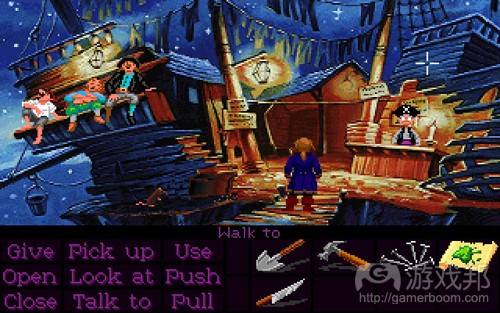

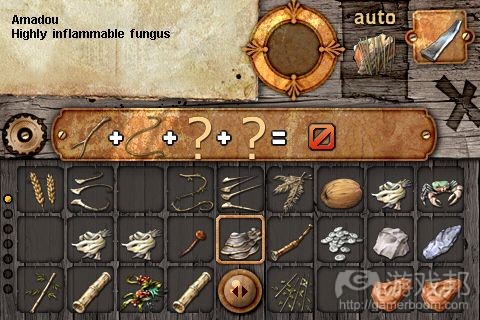

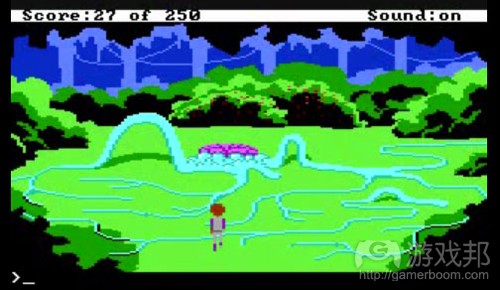

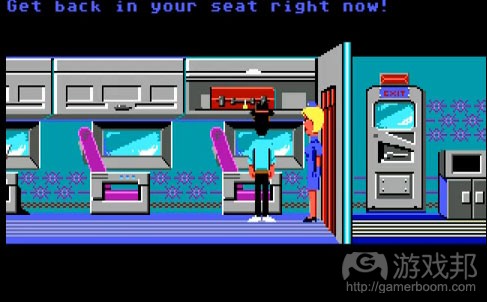
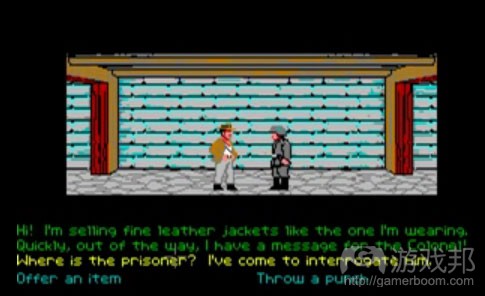
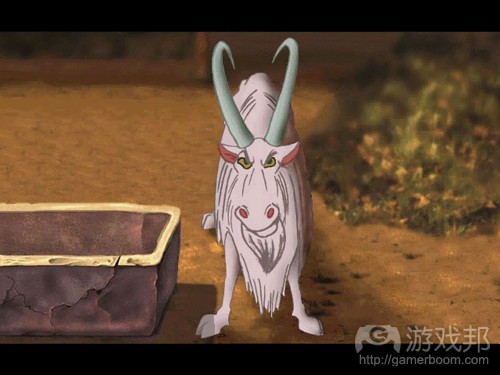

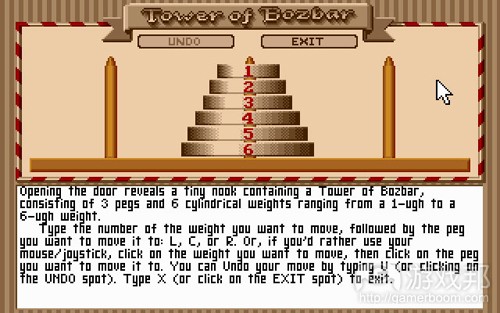
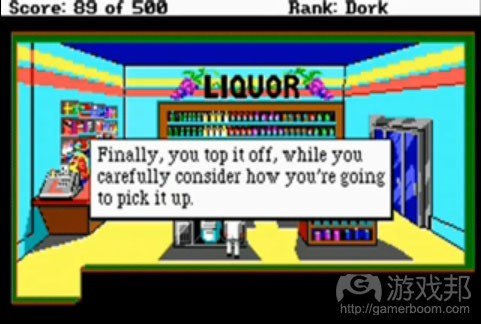


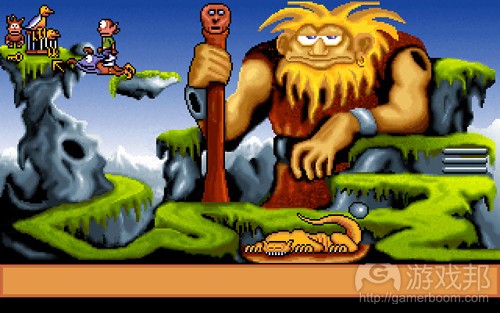














 闽公网安备35020302001549号
闽公网安备35020302001549号